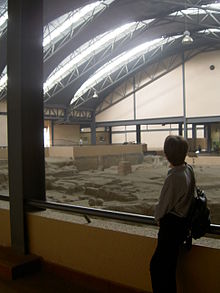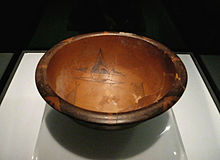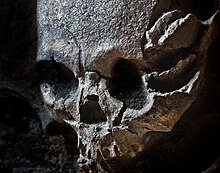| Revision as of 02:23, 20 September 2021 edit202.86.188.84 (talk)No edit summaryTag: Reverted← Previous edit | Revision as of 08:16, 20 September 2021 edit undoStation1 (talk | contribs)Autopatrolled, Extended confirmed users, Pending changes reviewers32,633 editsm rvvTag: Manual revertNext edit → | ||
| Line 28: | Line 28: | ||
| ].]] | ].]] | ||
| '''Banpo''' is an archaeological site discovered in 1953 and located in the ] just east of ], ]. It contains the remains of several well organized ] settlements, like ], ] to 6700–5600 ].<ref>{{cite book |doi=10.1007/978-90-481-8716-4_8 | chapter=Climate Change and Desertification with Special Reference to the Cases in China |title=Changing Climates, Earth Systems and Society |year=2010 |last1=Yang |first1=Xiaoping |isbn=978-90-481-8715-7 |pages=177–187}}</ref><ref>{{cite book |chapter-url=http://faravashi.ir/download/Stark%20(ed.)%202006%20Archaeology%20of%20Asia.pdf |chapter=East Asian plant domestication |pages=77–95 |title=Archaeology of |
'''Banpo''' is an archaeological site discovered in 1953 and located in the ] just east of ], ]. It contains the remains of several well organized ] settlements, like ], ] to 6700–5600 ].<ref>{{cite book |doi=10.1007/978-90-481-8716-4_8 | chapter=Climate Change and Desertification with Special Reference to the Cases in China |title=Changing Climates, Earth Systems and Society |year=2010 |last1=Yang |first1=Xiaoping |isbn=978-90-481-8715-7 |pages=177–187}}</ref><ref>{{cite book |chapter-url=http://faravashi.ir/download/Stark%20(ed.)%202006%20Archaeology%20of%20Asia.pdf |chapter=East Asian plant domestication |pages=77–95 |title=Archaeology of Asia | last1=Crawford | first1=Garry W. |editor-link1=Miriam Stark| editor=Miriam T. Stark |date=2004 |publisher=Blackwell Publishing Ltd}}</ref><ref>{{cite journal |url=http://www.homepages.ucl.ac.uk/~tcrndfu/articles/china%20overview%20pre.pdf |title=A Critical Assessment of Early Agriculture in East Asia, with emphasis on Lower Yangzte Rice Domestication |last1=Fuller |first1=Dorian Q |last2=Qin |first2=Ling |last3=Harvey |first3=Emma |journal=Pragdhara |year=2008 |pages=17–52}}</ref><ref>{{cite journal |pmid=21592462 |year=2011 |last1=Meng |first1=Y |last2=Zhang |first2=HQ |last3=Pan |first3=F |last4=He |first4=ZD |last5=Shao |first5=JL |last6=Ding |first6=Y |title=Prevalence of dental caries and tooth wear in a Neolithic population (6700-5600 years BP) from northern China |volume=56 |issue=11 |pages=1424–35 |doi=10.1016/j.archoralbio.2011.04.003 |journal=Archives of Oral Biology}}</ref> The area of {{convert|5|to|6|ha|sp=us|sigfig=2}} is surrounded by a ditch, probably a defensive moat, {{convert|5|to|6|m|ft|sp=us|sigfig=2}} wide. The houses were circular, built of mud and wood with overhanging thatched roofs. They sat on low foundations. There appear to be communal burial areas.<ref name=ching2>{{cite book |url=https://books.google.com/books?id=dEBY37og6PYC |pages=8–9 |title=A Global History of Architecture |isbn=9780470902455 |last1=Jarzombek |first1=Mark M |last2=Prakash |first2=Vikramaditya |date=2011-02-09}}</ref> | ||
| Banpo is the ] associated with ]. Archaeological sites with similarities to the first phase at Banpo are considered to be part of the “Banpo phase” (7th millennium BC) of the Yangshao culture. Banpo was excavated from 1954 to 1957. | Banpo is the ] associated with ]. Archaeological sites with similarities to the first phase at Banpo are considered to be part of the “Banpo phase” (7th millennium BC) of the Yangshao culture. Banpo was excavated from 1954 to 1957. | ||
Revision as of 08:16, 20 September 2021
For other uses, see Banpo (disambiguation).| 半坡 | |
 | |
 | |
| Location | Shaanxi |
|---|---|
| Region | China |
| Coordinates | 34°16′23″N 109°03′04″E / 34.273°N 109.051°E / 34.273; 109.051 |
| History | |
| Founded | 6700 BP |
| Abandoned | 5600 BP |
| Periods | Neolithic China |
| Cultures | Yangshao culture |



Banpo is an archaeological site discovered in 1953 and located in the Yellow River Valley just east of Xi'an, China. It contains the remains of several well organized Neolithic settlements, like Jiangzhai, carbon dated to 6700–5600 years ago. The area of 5 to 6 hectares (12 to 15 acres) is surrounded by a ditch, probably a defensive moat, 5 to 6 meters (16 to 20 ft) wide. The houses were circular, built of mud and wood with overhanging thatched roofs. They sat on low foundations. There appear to be communal burial areas.
Banpo is the type site associated with Yangshao Culture. Archaeological sites with similarities to the first phase at Banpo are considered to be part of the “Banpo phase” (7th millennium BC) of the Yangshao culture. Banpo was excavated from 1954 to 1957.
The settlement was surrounded by a moat, with the graves and pottery kilns located outside the moat perimeter. Many of the houses were semisubterranean with the floor typically 1 meter (3 ft) below the ground surface. The houses were supported by timber poles and had steeply pitched thatched roofs.
According to the Marxist paradigm of archaeology that was prevalent in the China during the time of the excavation of the site, Banpo was considered to be a matriarchal society; however, new research contradicts this claim and the Marxist paradigm is gradually being phased out in modern Chinese archaeological research. Currently, little can be said of the religious or political structure from these ruins from the archaeological evidence.
The site is now home to the Xi'an Banpo Museum, built in 1957 to preserve the archaeological collection.
See also
Footnotes
- Yang, Xiaoping (2010). "Climate Change and Desertification with Special Reference to the Cases in China". Changing Climates, Earth Systems and Society. pp. 177–187. doi:10.1007/978-90-481-8716-4_8. ISBN 978-90-481-8715-7.
- Crawford, Garry W. (2004). "East Asian plant domestication" (PDF). In Miriam T. Stark (ed.). Archaeology of Asia. Blackwell Publishing Ltd. pp. 77–95.
- Fuller, Dorian Q; Qin, Ling; Harvey, Emma (2008). "A Critical Assessment of Early Agriculture in East Asia, with emphasis on Lower Yangzte Rice Domestication" (PDF). Pragdhara: 17–52.
- Meng, Y; Zhang, HQ; Pan, F; He, ZD; Shao, JL; Ding, Y (2011). "Prevalence of dental caries and tooth wear in a Neolithic population (6700-5600 years BP) from northern China". Archives of Oral Biology. 56 (11): 1424–35. doi:10.1016/j.archoralbio.2011.04.003. PMID 21592462.
- ^ Jarzombek, Mark M; Prakash, Vikramaditya (2011-02-09). A Global History of Architecture. pp. 8–9. ISBN 9780470902455.
- Liu, Li (2004). The Chinese Neolithic. p. 11. ISBN 9781139441704.
- Lu, H.; Zhang, J.; Liu, K.-b.; Wu, N.; Li, Y.; Zhou, K.; Ye, M.; Zhang, T.; et al. (2009). "Earliest domestication of common millet (Panicum miliaceum) in East Asia extended to 10,000 years ago". Proceedings of the National Academy of Sciences. 106 (18): 7367–72. Bibcode:2009PNAS..106.7367L. doi:10.1073/pnas.0900158106. PMC 2678631. PMID 19383791.
- "Banpo Museum in Xi'an". chinamuseums.com. Archived from the original on 31 January 2018. Retrieved 29 July 2013.
References
- Allan, Sarah (ed), The Formation of Chinese Civilization: An Archaeological Perspective, ISBN 0-300-09382-9
- Chang, Kwang-chih. The Archaeology of Ancient China, ISBN 0-300-03784-8
| Prehistoric cultures of China | |
|---|---|
| Northeastern China | |
| Upper Yellow River | |
| Middle Yellow River | |
| Lower Yellow River | |
| Middle and Upper Yangtze | |
| Lower Yangtze and Huai | |
| Southern China | |
| Tibet | |
| Xinjiang | |
| Taiwan | |
| Other | |
| Shaanxi topics | |
|---|---|
| Xi'an (capital) | |
| Cities | |
| General | |
| Geography | |
| Education | |
| Culture | |
| Visitor attractions | |
- Populated places established in the 7th millennium BC
- History of Xi'an
- Archaeological sites in China
- Neolithic cultures of China
- Neolithic settlements
- Former populated places in China
- Archaeological type sites
- Major National Historical and Cultural Sites in Shaanxi
- 7th-millennium BC establishments
- Tourist attractions in Xi'an